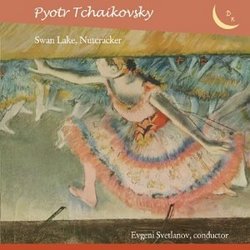| All Artists: Tchaikovsky, Svetlanov, USSR Symphony Orchestra Title: Swan Lake and Nutcracker suites Members Wishing: 0 Total Copies: 0 Label: CDK Music Original Release Date: 8/3/2003 Re-Release Date: 7/15/2003 Genre: Classical Styles: Ballets & Dances, Ballets Number of Discs: 1 SwapaCD Credits: 1 UPC: 634479523427 |
Search - Tchaikovsky, Svetlanov, USSR Symphony Orchestra :: Swan Lake and Nutcracker suites
 | Tchaikovsky, Svetlanov, USSR Symphony Orchestra Swan Lake and Nutcracker suites Genre: Classical Swan Lake Suite, Op. 20a, represents nine selected numbers from the "Swan Lake" ballet. Though Tchaikovsky considered making a suite from "Swan Lake" in 1882, this idea apparently came to nothing. After his death, others c... more » |
Larger Image |
CD Details
Synopsis
Album Description
Swan Lake Suite, Op. 20a, represents nine selected numbers from the "Swan Lake" ballet. Though Tchaikovsky considered making a suite from "Swan Lake" in 1882, this idea apparently came to nothing. After his death, others compiled and published one. It is interesting, that an earlier version of "Swan Lake" was composed in 1871, six years before the second one, which we know today. The first version was simple dance music, called "The Lake of Swans" composed for children and staged at the house of Tchaikovsky's sister, Alexandra, in Kamenka, Ukraine. The success of "Swan Lake", composed and premiered in 1877 at the Bolshoi theatre, was not easy. The first to rebel were the orchestral players. Bemused by the "unprecedented difficulty" of the score, they found little help from their "semi-amateur" conductor Stepan Ryabov. The situation very much reminds us of a story concerning the ballets by Prokofiev - a similar lack of appreciation was expressed in the same way by orchestral musicians many years later. "Swan Lake", as a successful ballet, dates from the 1895 revival with choreography by Moris Petipa and Lev Ivanov, at the Maryinsky Theatre in St. Petersburg. Nutcracker Suite, op. 71a, was completed by Tchaikovsky in 1892. It was an orchestral version of Hoffmann?s fantasy, Nutcracker, adapted by the composer to a ballet genre. Although Tchaikovsky considered the story to be lacking any real dramatic and emotional tension, his Nutcracker is one of the most fascinating achievements in ballet. An unusual feature of the score is the use of celesta, a very rare instrument at that time. It was ideal for music "with the sound of falling drops of water, as from a fountain." Tchaikovsky used it to characterize the Sugar Plum Fairy. A boy?s choir was another innovation in ballet music. Dances caracteristiques contains six parts. They were composed and publically performed before work on the ballet was finished. Tchaikovsky brought a capacity of symphonic organization to the ordinarily rather primitive art of ballet music. There is a reconciliation of dance elements with the demands of symphonic form, usage of large-scale musical structures. It brings greater strength and coherence to the organization of dance sequences. Divertissements play the secondary role in the ballet(suite) and help to combine structural dances, which form the core of the entire composition, into groups. The USSR People's Artist, Lenin prize winning conductor Evgeni Svetlanov was educated at the Gnessin Pedagogical Institute of Music, then at the Moscow Conservatory both in the class of composition (under Professor Yu. Shaporin) and conducting (under Professor A. Gauk). Svetlanov worked with the USSR Radio Symphony Orchestra, and later took over the USSR Bolshoi Theatre Orchestra. Since 1965 he was a Principal Conductor of the USSR Symphony Orchestra. With Russian classics as the focus of his attention (his repertoire is made up entirely of Russian music), Svetlanov constantly tackled works of different styles. His name is well known all over the world. ©2003 Evgeni Kostitsyn
